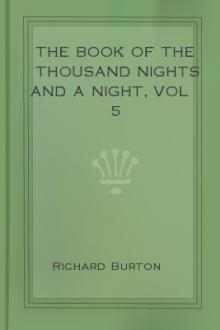The Book of the Thousand Nights and a Night, vol 6 by Sir Richard Francis Burton (best novels for students txt) 📖

- Author: Sir Richard Francis Burton
- Performer: -
Book online «The Book of the Thousand Nights and a Night, vol 6 by Sir Richard Francis Burton (best novels for students txt) 📖». Author Sir Richard Francis Burton
[FN#226] Arab. “Ashj�r,” which may mean either the door-posts or the wooden bolts. Lane (iii. 174) translates it “among the trees”
in a room!
[FN#227] Koran (ix. 51), when Mohammed reproaches the unbelievers for not accompanying him to victory or martyrdom.
[FN#228] Arab. “Kin�,” a true veil, not the “Burk� ” or “nose bag” with the peep-holes. It is opposed to the “Tarkah” or “head veil.” Europeans inveigh against the veil which represents the loup of Louis Quatorze’s day: it is on the contrary the most coquettish of contrivances, hiding coarse skins, fleshy noses, wide mouths and vanishing chins, and showing only lustrous and liquid black eyes. Moreover a pretty woman, when she wishes, will always let you see something under the veil. (Pilgrimage i. 337.) [FN#229] A yellow-flowered artemisia or absinthe whose wood burns like holm-oak. (Unexplored Syria ii. 43.) See vol. ii. 24 for further details.
[FN#230] The Farz or obligatory prayers, I have noted, must be recited (if necessary) in the most impure place; not so the other orisons. Hence the use of the “Sajj�dah” or prayer-rug an article too well known to require description.
[FN#231] Anglic� a stomach-ache, a colic.
[FN#232] Arab. “Al-H�fizah” which has two meanings. Properly it signifies the third order of Traditionists out of a total of five or those who know 300,000 traditions and their ascriptions.
Popularly “one who can recite the Koran by rote.” There are six great Traditionists whose words are held to be prime authorities; (1) Al-Bokh�ri, (2) Muslim, and these are entitled Al-Sah�hayn, The (two true) authorities. After them (3) Al-Tirmidi; and (4) Abu Da�d: these four being the authors of the “Four Sunan,” the others are (5) Al-Nas�i and (6) Ibn M�jah (see Jarrett’s Al-Siyuti pp. 2, 6; and, for modern Arab studies, Pilgrimage i.
154 et seq.).
[FN#233] Lane (iii. 176) marries the amorous couple, thus making the story highly proper and robbing it of all its point.
[FN#234] Arab. “Sabbahat,” i.e. Sabbah-ak’ Allah bi’l khayr =
Allah give thee good morning: still the popular phrase.
[FN#235] Arab. “Ta’r�sak,” with the implied hint of her being a “Mu’arrisah” or she pander. The Bresl. Edit. (xii. 356) bluntly says “Kiv�datak” thy pimping.
[FN#236] Arab. “Rafw”: the “Rafu-gar” or fine-drawer in India, who does this artistic style of darning, is famed for skill.
[FN#237] The question sounds strange to Europeans, but in the Moslem East a man knows nothing, except by hearsay, of the women who visit his wife.
[FN#238] Arab. “Ahl al-bayt,” so as not rudely to say “wife.”
[FN#239] This is a mere abstract of the tale told in the Introduction (vol. i. 10-12). Here however, the rings are about eighty; there the number varies from ninety to five hundred and seventy.
[FN#240] The father suspected the son of intriguing with one of his own women.
[FN#241] Arab. and Heb. “Laban” (opp. to “laban-hal�b,” or simply “hal�b” = fresh milk), milk artificially soured, the Dahin of India, the Kisain� of the Slavs and our Corstophine cream. But in The Nights, contrary to modern popular usage, “Laban” is also applied to Fresh milk. The soured form is universally in the East eaten with rice and enters into the Sal�tah or cucumber-salad. I have noted elsewhere that all the Galactophagi, the nomades who live on milk, use it in the soured never in the fresh form. The Badawi have curious prejudices about it: it is a disgrace to sell it (though not to exchange it), and “Labb�n,” or “milk-vendor,”
is an insult. The Br�hni and Beloch pomades have the same pundonor possibly learnt from the Arabs (Pilgrimage i. 363). For �Igt (Akit), Mahir, Saribah, Jam�dah and other lacteal preparations, see ibid. i. 362.
[FN#242] I need hardly say that the poison would have been utterly harmless, unless there had been an abrasion of the skin.
The slave-girl is blamed for carrying the jar uncovered because thus it would attract the evil eye. In the Book of Sindibad the tale appears as the Story of the Poisoned Guest; and the bird is a stork.
[FN#243] The Prince expresses the pure and still popular Moslem feeling; and yet the learned and experienced Mr Redhouse would confuse this absolute Predestination with Providence. A friend tells me that the idea of absolute Fate in The Nights makes her feel as if the world were a jail.
[FN#244] In the Book of Sindibad this is the Story of the Sandal-wood Merchant and the Advice of the Blind Old Man. Mr.
Clouston (p. 163) quotes a Talmudic joke which is akin to the Shaykh’s advice and a reply of Tyl Eulenspiegel, the arch-rogue, which has also a family resemblance.
[FN#245] Arab. “S�‘a,” a measure of corn, etc., to be given in alms. The Kamus makes it = four mudds (each being 1/3 lbs.); the people understand by it four times the measure of a man’s two open hands.
[FN#246] i.e. till thou restore my eye to me. This style of prothesis without apodosis is very common in Arabic and should be preserved in translation, as it adds a na�vet� to the style. We find it in Genesis iii. 2, “And now lest he put forth his hand,”
etc.
[FN#247] They were playing at Mur�hanah, like children amongst us. It is also called “Hukm wa Riz�” = order and consent. The penalty is usually something ridiculous, but here it was villainous.
[FN#248] Every Moslem capital has a “Shaykh of the thieves” who holds a regular lev�es and who will return stolen articles for consideration; and this has lasted since the days of Diodorus Siculus (Pilgrimage i. 91).
[FN#249] This was not the condition; but I have left the text as it is characteristic of the writer’s inconsequence.
[FN#250] The idea would readily occur in Egypt where the pulex is still a plague although the Sultan is said to hold his court at Tiberias. “Male and female” says the rouge, otherwise it would be easy to fill a bushel with fleas. The insect was unknown to older India according to some and was introduced by strangers. This immigration is quite possible. In 1863 the jigger (P. penetrans) was not found in Western Africa; when I returned there in 1882 it had passed over from the Brazil and had become naturalised on the equatorial African seaboard. the Arabs call shrimps and prawns “sea-fleas” (barg�th al-bahr) showing an inland race. (See Pilgrimage i. 322.)
[FN#251] Submission to the Sultan and the tidings of his well-being should content every Eastern subject. But, as Oriental history shows, the form of government is a Despotism tempered by assassination. And under no rule is man socially freer and his condition contrasts strangely with the grinding social tyranny which characterises every mode of democracy or constitutionalism, i.e. political equality.
[FN#252] Here the text has “Mark�b” = a shoe; elsewhere “Na’al” =
a sandal, especially with wooden sole. In classical Arabia, however, “Na’al” may be a shoe, a horseshoe (iron-plate, not rim like ours). The Bresl. Edit. has “Wat�,” any foot-gear.
[FN#253] Water-melons (bat�yikh) says the Mac. Edit. a misprint for Aruz or rice. Water-melons are served up raw cut into square mouthfuls, to be eaten with rice and meat. They serve excellently well to keep the palate clean and cool.
[FN#254] The text recounts the whole story over again - more than European patience can bear.
[FN#255] The usual formula when telling an improbable tale. But here it is hardly called for: the same story is told (on weak authority) of the Alewife, the Three Graziers and Attorney-General Nay (temp. James II. 1577-1634) when five years old (Journ. Asiat. Soc. N.S. xxx. 280). The same feat had been credited to Thomas Egerton, Lord Chancellor in A.D. 1540-1617
(Chalmers, Biographical Dictionary xxiii. 267-68). But the story had already found its way into the popular jest-books such as “Tales and Quick Answers, very Mery and Pleasant to Rede” (1530); “Jacke of Dover’s Quest of Inquirie for the Foole of all Fooles”
(1604) under the title “The Foole of Westchester”, and in “Witty and Entertaining Exploits of George Buchanan, commonly called the King’s Fool.” The banker-bard Rogers (in Italy) was told a similar story concerning a widow of the Lambertini house (xivth centry). Thomas Wright (Introducition to the Seven Sages) says he had met the tale in Latin( xiiith-xivth centuries) and a variant in the “Nouveaux Contes � rire (Amsterdam 1737), under the title “Jugement Subtil du Duc d’Ossone contre Deux Marchands.” Its origin is evidently the old Sindib�d-namah translated from Syriac into Greek (“Syntipas,” xith century); into Hebrew (Mishl�
Sandabar, xiith century) and from the Arabian version into old Castilian, “Libro de los Engannos et los Asayamientos de las Mugeres” (A.D. 1255), whereof a translation is appended to Professor Comparetti’s Socitey. The Persion metrical form (an elaboration of one much older) dates from 1375; and gave rise to a host of imitations such as the Turkish Tales of the Forty Wazirs and the Canarese “Kath� Manjari,” where four persons contend about a purse. See also Gladwin’s “Persian Moonshee,” No.
vi. of “Pleasing Stories;” and Mr. Clouston’s paper, “The Lost Purse,” in the Glasgow Evening Times. All are the Eastern form of Gavarni’s “Enfants Terribles,” showing the portentous precocity for which some children (infant phenomena, calculating boys, etc.
etc.) have been famous.
[FN#256] From the Bresl. Edit. xii. 381. The Sa’lab or Abu Hosayn (Father of the Fortlet) is the fox, in Marocco Akk�b: Talib Yusuf and Wa’wi are the jackal. Arabas have not preserved “Jakal” from the Heb. Shu’al and Persian Shaghal and Persian Shagh�l (not Shagul) as the Rev. Mr. Tristram misinforms his readers. (Nat.
Hist. p. 85)
[FN#257] The name is old and classical Arabic: in Antar the young Amazon Jayd� was called Judar in public (Story of Jayd� and Kh�lid). It is also, as will be seen, the name of a quarter in Cairo, and men are often called after such places, e.g. Al-Jubn�
from the S�k al Jubn in Damascus. The story is exceedingly Egyptian and the style abounds in Cairene vulgarisms, especially in the Bresl. Edit. ix. 311.
[FN#258] Had the merchant left his property to be divided after his death and not made a will he widow would have had only one-eighth instead of a fourth.
[FN#259] Lit. “from tyrant to tyrant,” i.e. from official to official, Al-Zalamah, the “tyranny” of popular parlance.
[FN#260] The coin is omitted in the text but it is evidently the “Nusf” or half-dirham. Lane (iii.235), noting that the dinar is worth 170 “nusfs” in this tale, thinks that it was written (or copied?) after the Osmanh Conquest of Egypt. Unfortunately he cannot tell the precise period when the value of the small change fell so low.
[FN#261] Arab “Yaum mub�rak!” still a popular exclamation.
[FN#262] i.e. of the door of daily bread.
[FN#263] Arab. “S�rah,” a small fish differently described (De Sacy, “Relation de l’Egypte par Abd allatif,” pp. 278-288: Lane, Nights iii. 234. It is not found in Sonnini’s list.
[FN#264] A tank or lakelet in the southern parts of Cairo, long ago filled up; Von Hammer believes it inherited the name of the old Charon’s Lake of Memphis, over which corpses were ferried.
[FN#265] Thus making the agreement a kind of religious covenant, as Catholics would recite a Pater or an Ave Maria.
[FN#266] Arab. “Y� misk�m”=O poor devil;





Comments (0)